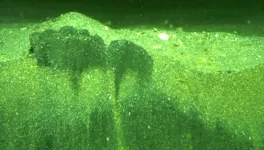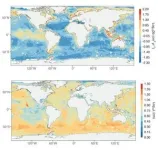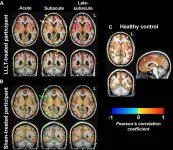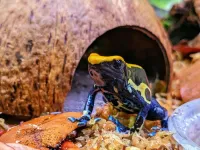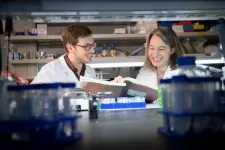(Press-News.org) A pioneering study has used extensive global datasets and machine learning to map the activities of seafloor invertebrate animals, including worms, clams and shrimps, across the entire ocean, revealing for the first time critical factors that support and maintain the health of marine ecosystems.
The international team, led by Texas A&M University and including investigators from Yale University and the University of Southampton, specifically focused on the unsung yet vital role burrowing animals play as "ecosystem engineers" in shaping nutrient cycling and ecosystem health — and, in turn, maritime economies and food security — throughout the oceans. The researchers used machine learning to map out a global picture of these animals' activities and the environmental conditions that drive them.
Marine sediments cover the majority of the Earth’s surface and are extremely diverse. By stirring up and churning the seafloor — a process known as bioturbation — seafloor invertebrates play a significant role in regulating global carbon, nutrient and biogeochemical cycles, explains Texas A&M Department of Oceanography Assistant Professor Dr. Shuang Zhang, lead researcher and first author of the study, which is published May 22 in the Cell Press journal Current Biology.
"Knowing how bioturbation links to other aspects of the environment means that we are now better equipped to predict how these systems might change in response to climate change," added Zhang, who is also a member of the CArbon Cycle and Earth Environment (CACEE) Lab at Texas A&M.
Working with trained models and global datasets of bioturbation, the team factored in seawater depth, primary productivity, sediment type and other criteria to investigate how the ocean environments in which these animals live influence how intensively and deeply mixed the seafloor is around the world.
"Through our analysis, we discovered that not just one, but multiple environmental factors jointly influence seafloor bioturbation and the ecosystem services these animals provide," said Dr. Lidya Tarhan, an assistant professor in the Department of Earth and Planetary Sciences at Yale. "This includes factors that directly impact food supply, underlying the complex relationships that sustain marine life, both today and in Earth’s past."
In addition to showing that current efforts to protect marine ecosystems have fallen short by not targeting these animals, the researchers note that their study has important ramifications for how we protect and conserve the ocean.
"We have known for some time that ocean sediments are extremely diverse and play a fundamental role in mediating the health of the ocean, but only now do we have insights about where, and by how much, these communities contribute," said Dr. Martin Solan, a professor of marine ecology at Southampton. “For example, the way in which these communities affect important aspects of ocean ecosystems are very different between the coastlines and deep sea.”
Tarhan says the ability to anticipate these changes is vital for developing strategies to mitigate habitat deterioration and protect marine biodiversity.
“Our analysis suggests that the present global network of marine protected areas does not sufficiently protect these important seafloor processes, indicating that protection measures need to be better catered to promote ecosystem health,” she added.
According to Zhang, the team is already planning their next joint collaboration, building on the findings of the present study. Despite having a clearer picture of geographic patterns in bioturbation, he says major questions remain regarding how this translates into the many ecosystem services society relies upon, such as food security, climate regulation and biogeochemical cycling. Ultimately, Zhang asserts that researchers need to determine how best to protect seafloor communities and anticipate how these communities respond to a changing climate.
“Tackling these really big questions is vital, but as we have established here, it requires an international team with a diversity of expertise to fully address these problems,” Zhang added. “By working together as we have done here, we expect additional exciting findings shortly.”
The team's research was funded in part by the Natural Environment Research Council and Yale, which is where Zhang earned his Ph.D. in 2017. Their paper, “Global distribution and environmental correlates of marine bioturbation,” can be viewed online along with related figures and captions.
By Shana K. Hutchins, Texas A&M University College of Arts and Sciences
###
END
Texas A&M-led team creates first global map of seafloor biodiversity activity
The map shows burrowing animals' activities and the environmental conditions that drive their efforts to shape healthy oceans.
2024-05-28
ELSE PRESS RELEASES FROM THIS DATE:
Light therapy increases brain connectivity following injury
2024-05-28
OAK BROOK, Ill. – Low-level light therapy appears to affect healing in the brains of people who suffered significant brain injuries, according to a study published today in Radiology, a journal of the Radiological Society of North America (RSNA).
Lights of different wavelengths have been studied for years for their wound-healing properties. Researchers at Massachusetts General Hospital (MGH) conducted low-level light therapy on 38 patients who had suffered moderate traumatic brain injury, an injury to the head serious enough to alter cognition and/or be visible on a brain scan. Patients received ...
Power imbalance in health care reveals impact of race and role on team dynamics and DEI efforts
2024-05-28
Background and Goal: Team-based care is considered the gold standard in delivery models. It uses integrated clinical teams with diverse skills and perspectives to provide efficient, high-quality health care services. Within these teams, individuals from minoritized racial-ethnic groups, often referred to as persons of color (POC), typically occupy roles with less authority (e.g., medical assistants), while white individuals more frequently hold positions of greater power (e.g., physicians). Few studies have explored the viewpoints of staff members in lower-power roles, who are disproportionately POC and constitute the majority of a health care team. This study aims to ...
NRG Oncology appoints new vice-chairs for their patient advocate committee
2024-05-28
NRG Oncology (NRG), a National Cancer Institute (NCI) National Clinical Trials Network (NCTN) group focused on improving outcomes for adults with cancer through multi-center clinical research, recently announced two new Vice-Chairs to co-lead the NRG Patient Advocate Committee (PAC) alongside the current PAC Committee Chair, Dorothy Erlanger.
Marlyn Molero, was appointed as Vice-Chair of the NRG PAC. Marlyn is a clinical researcher in the oncology area with Commonspirit Research Institute as well as a Spanish interpreter at Vituity. Marlyn brings a unique perspective to the NRG PAC leadership ...
Why do Dyeing poison frogs tap dance?
2024-05-28
The toe tapping behavior of various amphibians has long attracted attention from researchers and pet owners. Despite being widely documented, the underlying functional role is poorly understood. In a new paper, researchers demonstrate that Dyeing poison frogs modulate their taps based on specific stimuli.
Dyeing poison frogs, Dendrobates tinctorius, have been shown to tap their posterior toes in response to a range of prey sizes, from small fruit flies to large crickets. In the present study, ...
UC Irvine study reveals circadian clock can be leveraged to enhance cancer immunotherapy
2024-05-28
Irvine, Calif., May 28, 2024 — A multidisciplinary research team at the University of California, Irvine has revealed that the circadian clock – the biological pacemaker that governs daily rhythms in physiological processes, including immune functions – can be leveraged to enhance the efficacy of checkpoint inhibitor cancer therapy. Checkpoint inhibitors block different proteins from binding to tumor cells, allowing the immune system’s T cells to kill the tumor.
The study, published online ...
Cell-targeting technology allows researchers to isolate neuronal subpopulations and link them to behavioral states
2024-05-28
(MEMPHIS, Tenn. – May 27, 2024) As gene sequencing technologies become more powerful, our understanding of cellular diversity has grown in parallel. This led scientists at St. Jude Children’s Research Hospital to create a tool to improve the ease and accuracy with which investigators can study specific subpopulations of cells. The tool, named Conditional Viral Expression by Ribozyme Guided Degradation (ConVERGD), allows researchers to specifically access these subgroups of cells and precisely manipulate ...
When should you neuter or spay your dog?
2024-05-28
Researchers at the University of California, Davis, have updated their guidelines on when to neuter 40 popular dog varieties by breed and sex. Their recent paper in Frontiers in Veterinary Science adds five breeds to a line of research that began in 2013 with a study that suggested that early neutering of golden retrievers puts them at increased risk of joint diseases and certain cancers.
That initial study set off a flurry of debate about the best age to neuter other popular breeds. Professors Lynette and Benjamin Hart of the School of Veterinary Medicine, the study’s lead authors, set out to add more breed studies by examining more than a decade ...
Is it a sound of music…or of speech? Scientists uncover how our brains try to tell the difference
2024-05-28
Music and speech are among the most frequent types of sounds we hear. But how do we identify what we think are differences between the two?
An international team of researchers mapped out this process through a series of experiments—yielding insights that offer a potential means to optimize therapeutic programs that use music to regain the ability to speak in addressing aphasia. This language disorder afflicts more than 1 in 300 Americans each year, including Wendy Williams and Bruce Willis.
“Although music and speech are different in many ways, ranging from pitch to timbre to sound texture, ...
New test rapidly diagnoses Toxoplasma infections and reduces false positives
2024-05-28
An inexpensive, accurate test that detects infections with the parasite Toxoplasma gondii can provide results within 30 minutes from a finger-prick in a doctor’s office or within an hour from a small blood sample tested in a local medical laboratory. The new test can also identify false positives in other types of commercial diagnostic tests for toxoplasmosis, providing swift reassurance to uninfected pregnant women and their doctors and facilitating timely interventions to protect a fetus against toxoplasmosis in acutely infected pregnant mothers.
These findings appear in a study, led by toxoplasmosis specialist Rima McLeod, MD, ...
Overlooked lipid connected to ancient cellular pathway with links to cancer
2024-05-28
Within the family of cell membrane lipids known as phosphoinositides and the kinase enzymes that regulate them, phosphoinositide 3-kinases (PI3Ks) have been cast in a starring role as scientists study their involvement in cancer, diabetes and many cellular activities.
The presence of PI3Ks in the scientific limelight has overshadowed other members of this lipid enzyme family, including phosphatidylinositol-5-phosphate 4-kinases (PI5P4Ks). Brooke Emerling, Ph.D., co-director of, and associate professor in, the Cancer Metabolism and Microenvironment Program at Sanford Burnham Prebys, is contributing to a revival of interest in this underappreciated set of enzymes.
Emerling and team have ...
LAST 30 PRESS RELEASES:
Numbers in our sights affect how we perceive space
SIMJ announces global collaborative book project in commemoration of its 75th anniversary
Air pollution exposure and birth weight
Obstructive sleep apnea risk and mental health conditions among older adults
How talking slows eye movements behind the wheel
The Ceramic Society of Japan’s Oxoate Ceramics Research Association launches new international book project
Heart-brain connection: international study reveals the role of the vagus nerve in keeping the heart young
Researchers identify Rb1 as a predictive biomarker for a new therapeutic strategy in some breast cancers
Survey reveals ethical gaps slowing AI adoption in pediatric surgery
Stimulant ADHD medications work differently than thought
AI overestimates how smart people are, according to HSE economists
HSE researchers create genome-wide map of quadruplexes
Scientists boost cell "powerhouses" to burn more calories
Automatic label checking: The missing step in making reliable medical AI
Low daily alcohol intake linked to 50% heightened mouth cancer risk in India
American Meteorological Society announces Rick Spinrad as 2026 President-Elect
Biomass-based carbon capture spotlighted in newly released global climate webinar recording
Illuminating invisible nano pollutants: advanced bioimaging tracks the full journey of emerging nanoscale contaminants in living systems
How does age affect recovery from spinal cord injury?
Novel AI tool offers prognosis for patients with head and neck cancer
Fathers’ microplastic exposure tied to their children’s metabolic problems
Research validates laboratory model for studying high-grade serous ovarian cancer
SIR 2026 delivers transformative breakthroughs in minimally invasive medicine to improve patient care
Stem Cell Reports most downloaded papers of 2025 highlight the breadth and impact of stem cell research
Oxford-led study estimates NHS spends around 3% of its primary and secondary care budget on the health impacts of heat and cold in England
A researcher’s long quest leads to a smart composite breakthrough
Urban wild bees act as “microbial sensors” of city health.
New study finds where you live affects recovery after a hip fracture
Forecasting the impact of fully automated vehicle adoption on US road traffic injuries
Alcohol-related hospitalizations from 2016 to 2022
[Press-News.org] Texas A&M-led team creates first global map of seafloor biodiversity activityThe map shows burrowing animals' activities and the environmental conditions that drive their efforts to shape healthy oceans.
